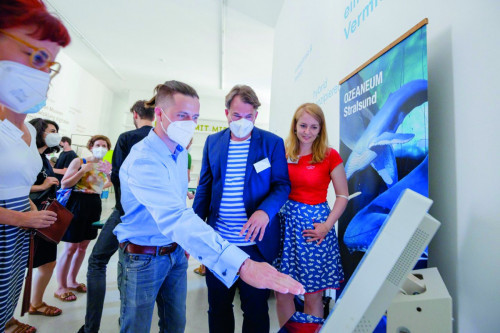The various Fraunhofer Institutes primarily conduct applied research for industry. However, the research results can also be of use to the general public in the cultural field. In this way, the general public can gain deeper insights into the capabilities of the research institutes and take a look behind the scenes.
 Practical test: Gesture control of a virtual penguin in the German Oceanographic MuseumThevarious Fraunhofer institutes primarily conduct applied industry research. But the research results can also be of use to the general public in the cultural sphere. In this way, the general public can gain deeper insights into the performance of the research institutes and take a look behind their scenes.
Practical test: Gesture control of a virtual penguin in the German Oceanographic MuseumThevarious Fraunhofer institutes primarily conduct applied industry research. But the research results can also be of use to the general public in the cultural sphere. In this way, the general public can gain deeper insights into the performance of the research institutes and take a look behind their scenes.
In the pilot project 'museum4punkt0 - Digital Strategies for the Museum of the Future' of the Fraunhofer Institute for Photonic Microsystems (IPMS) Dresden and the German Oceanographic Museum with the Ozeaneum site in Stralsund, the requirements for research from a non-industrial sector are now also to be taken into account.
The aim of the pilot project is to create new interaction opportunities for museum visitors. The pandemic in particular has shown how important contactless interaction between visitors and exhibits is. Until now, touchscreens, levers and buttons have been touched thousands of times. This is not very hygienic, even if these controls are regularly disinfected. The museum was looking for possibilities for contactless interaction and came across the Fraunhofer IPMS.
The principle of gesture control
Among other things, the institute develops microscopically small structures that generate ultrasound. These structures can be used for gesture control. The principle is based on the transmission of ultrasonic waves and the subsequent detection of echo signals from the environment. Such systems are already being used in industry. The particular challenges at the Ozeaneum in Stralsund are the unfavorable lighting conditions - the rooms are often darkened, for example - and the limited space available. Under these conditions, the control systems should still function reliably and also enable intuitive operation. To this end, IPMS has developed a demonstrator that allows museum visitors to control a penguin appearing on the screen with a wave of the hand. Visitors young and old can then have the penguin catch sprats for its chicks in the water. The technology, which is based on ultrasonic signals, converts intuitive gestures into control commands. There is no need to touch any surfaces.
Outlook
At the end of June this year, IPMS handed over the demonstrator to the German Oceanographic Museum. The aim now is to find out - also by means of visitor surveys - how museum visitors accept this form of interaction. The results will be incorporated into technology development at the Fraunhofer Institute.


